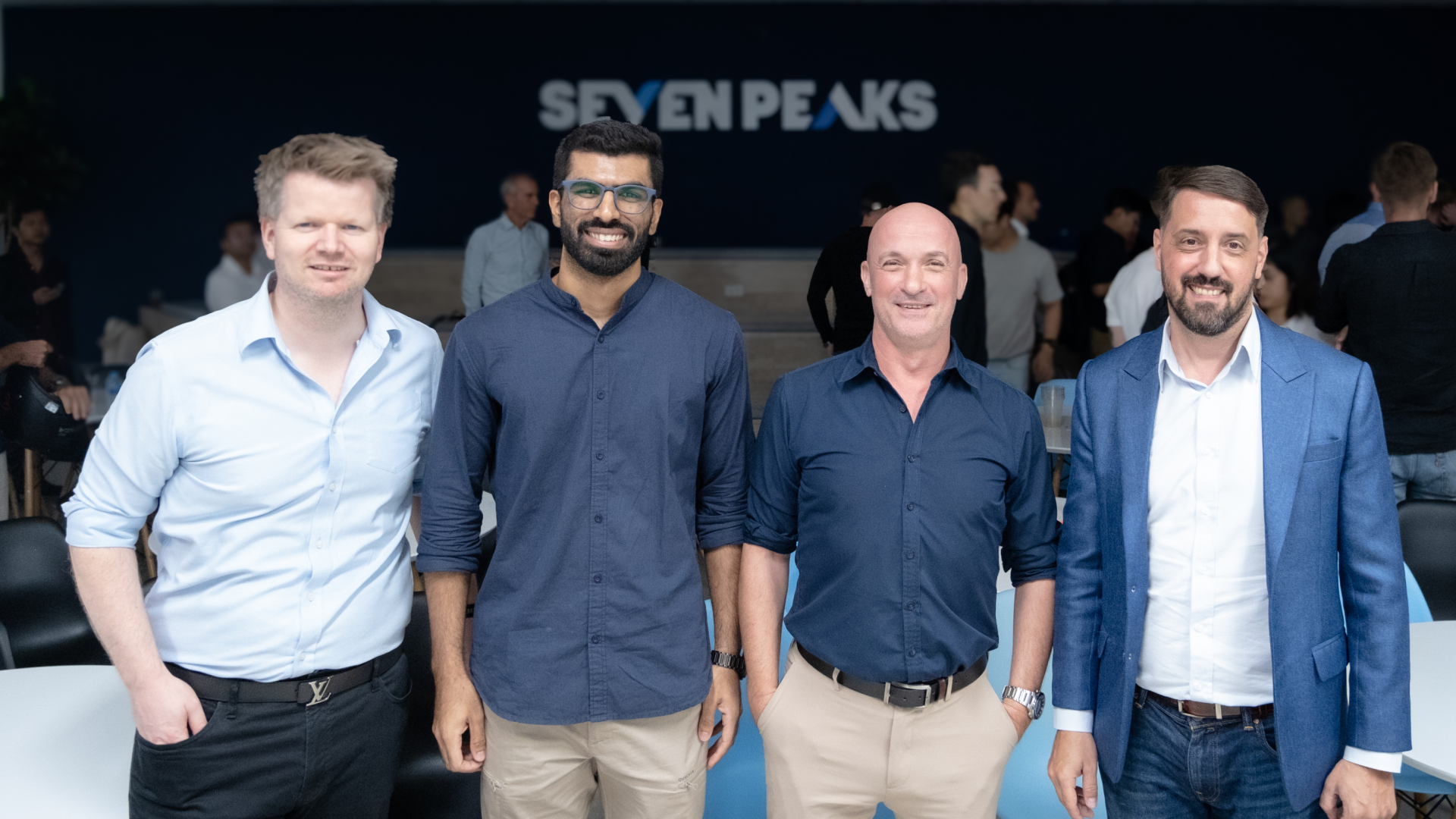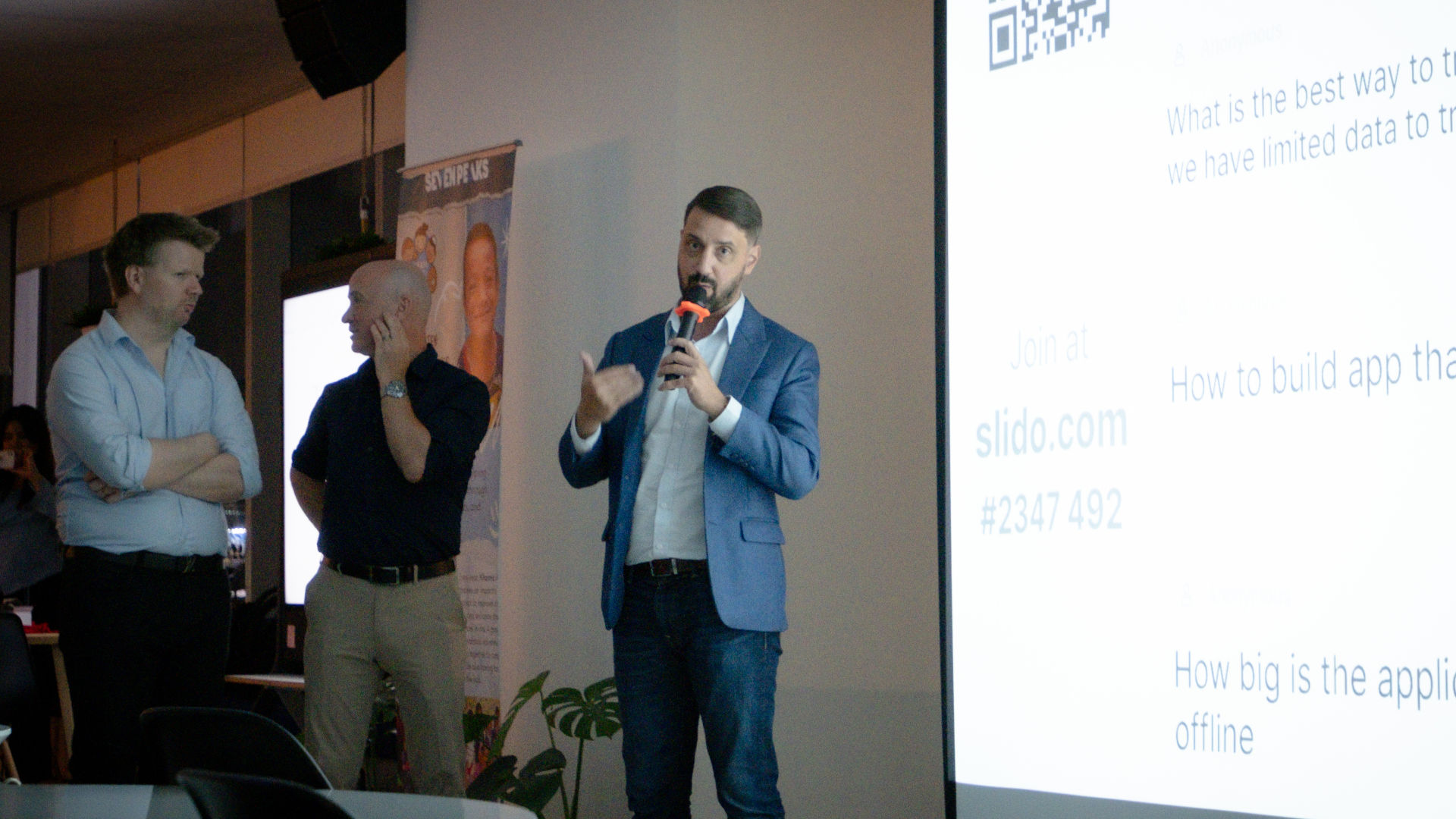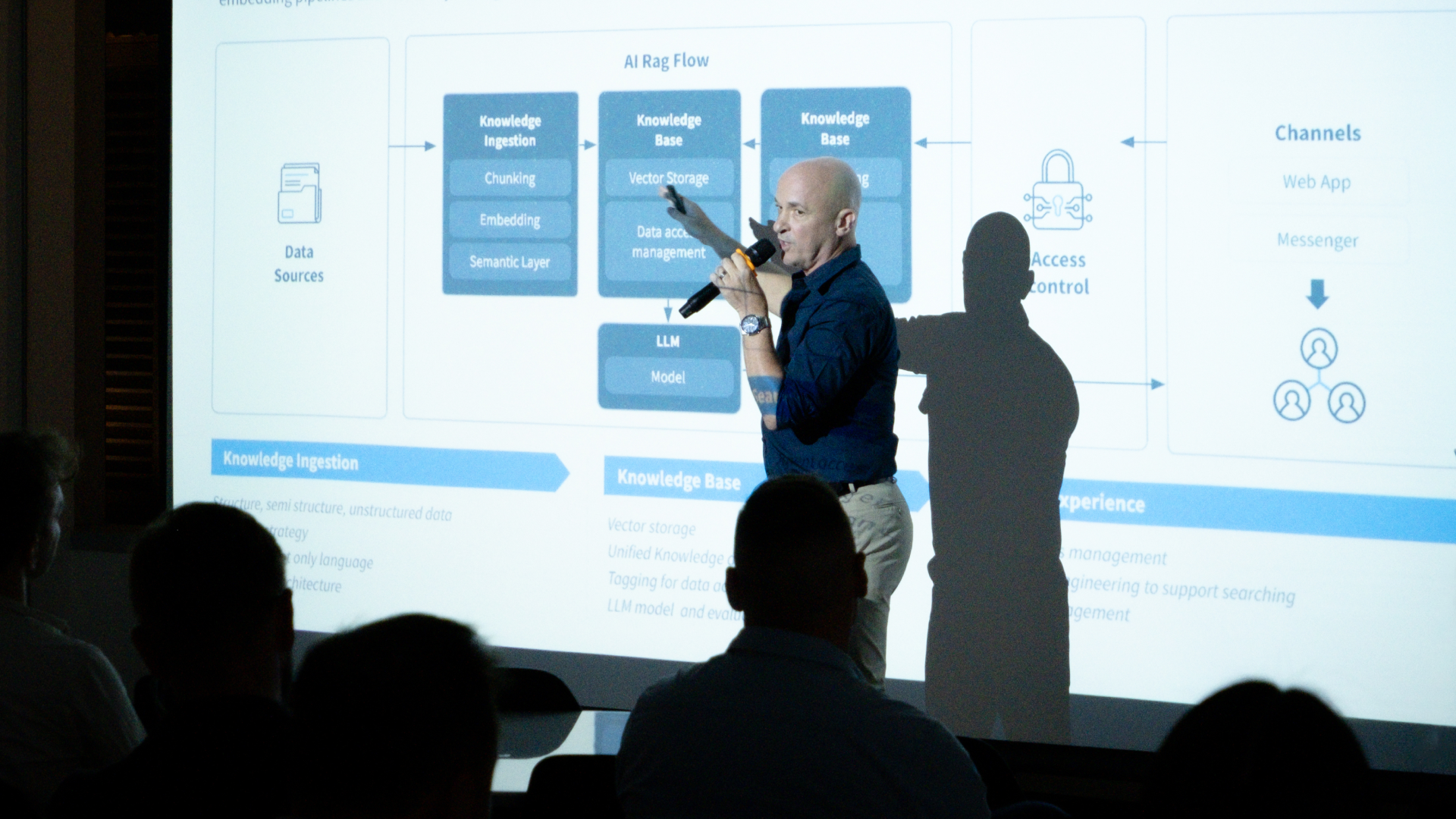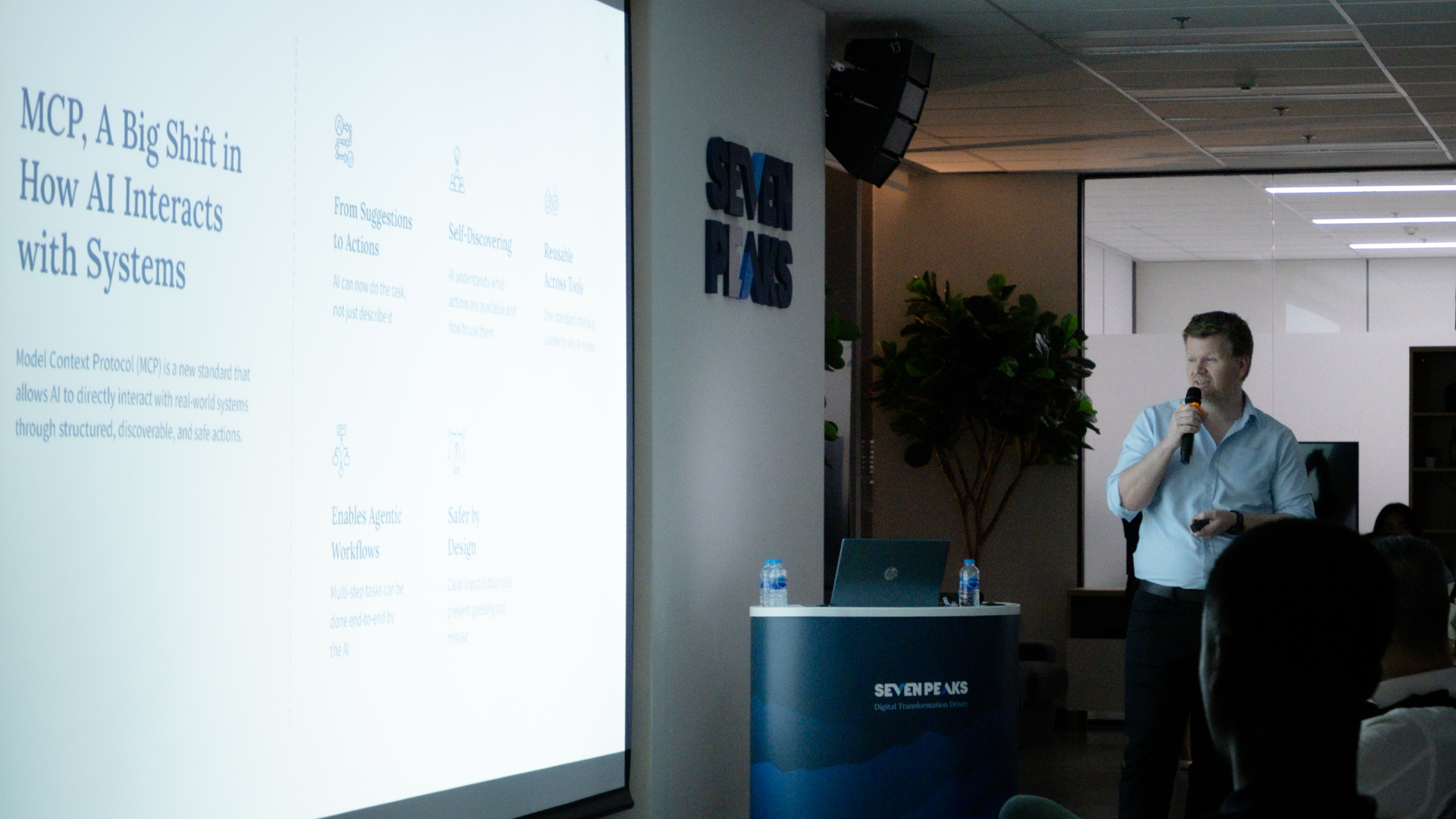Share this
Building Intelligent Apps, from Strategy to Launch
by Seven Peaks on Sep. 19, 2025

On Thursday, August 28th, Seven Peaks hosted Building Intelligent Apps: From Strategy to Launch at our Bangkok headquarters. The event brought together industry professionals including Seven Peaks' Jeremie Tisseau (Chief Design Officer), Damien Velly (VP of Data and Analytics), and Leif Mork (VP of Digital Product), alongside Pulkit Midha, Developer Evangelist from event sponsor Couchbase.
Their presentations offered several important takeaways and strategic models.
What makes an app intelligent?
The first step in any successful AI strategy is a shift in mindset. For too long, businesses have thought of AI as something to layer on top of existing SaaS products. Instead, you should see it as a core element of your business strategy.

Jeremie Tisseau, Chief Design Officer at Seven Peaks
An AI-first approach takes applications far beyond static dashboards. By having development teams put AI at the core of apps, intelligent apps can continuously think, act, and anticipate user needs. The result can be fully interactive, embedded user interfaces that offer proactive insights and recommendations right where uses are.
Consider your average HR system that just stores employee data in a database for HR people to call up when needed. Then think about a system that actively analyzes performance metrics, feedback patterns, and attendance logs before identifying at-risk employees and recommending interventions like mentorship programs and workload adjustments.

Analysts at Gartner predict that by 2028 a third of all enterprise applications will feature agentic AI. Central to these workflows is the Model Context Protocol (MCP) standard. MCPs allow AI to directly interact with enterprise systems through structured, discoverable actions without needing specific APIs for every action. This enables AI to complete multi-step processes autonomously.

Damien Velly, VP of Data and Analytics at Seven Peaks Software
Curating data as a foundation for intelligence
Intelligent applications are only as effective as their underlying data infrastructure. Success begins with strong data governance and full compliance with regulations like GDPR to reduce privacy risks and prevent bias in AI models. Non-compliance can lead to significant penalties, especially in regions like Europe.
Most firms sit on fragmented, unlabeled, and ungoverned data. To add to the problem, AI has a tendency to hallucinate when working with vast amounts of data. Many remedies have been tried to combat both problems, but the current best practice is Retrieval Augmented Generation, or RAG. A typical AI RAG Workflow contains three parts: data, a knowledge base, and a large language model.
- Raw data is extracted and processed through chunking, embedding, and semantic organization.
- A knowledge base stores this AI-optimized data in vector databases (see below) made for similarity searches.
- LLM integration involves large language models like ChatGPT interacting with the curated knowledge base to generate accurate, contextually relevant responses.
Building trust in AI requires constant vigilance. AI models must be continuously monitored to prevent issues like data drifting and to ensure fairness over time. With a well-designed knowledge base and proper access management, AI can securely process financial data for tasks like invoice reconciliation, turning a lengthy process into an efficient one.

Leif Mork, VP of Digital Product at Seven Peaks Software
A practical roadmap for building AI-native applications
Building intelligent applications requires a disciplined, phased approach that balances innovation with risk management. It involves iterating fast, but scaling carefully, with the right balance between experimentation and operational maturity. To do so requires an agile process.
1. Define the problem
Target specific use cases where AI can address repetitive tasks, information overload, or existing bottlenecks where AI can make an immediate impact.
2. Create a proof of concept
Use established platforms from major providers (Google, Microsoft, OpenAI) for rapid validation before committing to custom development.
3. Develop an MVP
Focus on solutions that can be tested in real-world environments with measurable success criteria.
4. Scale securely
Implement proper data governance, security measures, and strong APIs with clear authentication, rate limiting, and audit capabilities.

The Model Context Protocol plays an important part in scaling. Rather than simply providing recommendations, MCP-enabled applications can execute complete workflows, from identifying requirements during a proof of concept to completing financial transactions in a working app.

Pulkit Midha, Developer Evangelist at Couchbase
Offline-first apps with vector search
The next step for intelligent applications lies at the edge, meaning not in some central database, but on mobile devices and IoT systems that live at the edge of a network of interconnected devices. And with huge amounts of data generated on these devices, processing data locally is necessary for reducing latency and improving privacy.
Vector databases support this intelligence by storing multi-dimensional representations of data locally on devices. It supports rapid, accurate searches, similar to how e-commerce platforms instantly return related products. When combined with RAG architectures, these systems can deliver accurate, context-aware responses even without internet connectivity. This is especially useful for field applications, remote operations, and scenarios where network reliability is a concern. Organizations can maintain intelligent functionality while ensuring data privacy and reducing delays.

Strategic effects
The convergence of agentic AI, solid data governance, and on-device computing capabilities represents a major opportunity for competitive differentiation. Organizations that successfully use these technologies will benefit from the following.
- Automated decision-making and process execution for better operational efficiency
- Proactive, context-aware interfaces for an improved user experience
- Reduced human error and improved compliance for better risk management
- Greater scalability with systems that adapt and improve over time
The secret to success lies in approaching intelligent application development as a strategic initiative that requires careful planning, proper infrastructure, and an ongoing commitment to data quality and governance.
As technologies continue to change, the organizations that treat AI as central to business, rather than a tactical tool, will be best positioned to capitalize on the opportunities ahead.
Follow us on Facebook and LinkedIn to stay up to date on our upcoming events.
Share this
- Product Development (86)
- Service Design (67)
- Data Analytics (53)
- Product Design (51)
- Industry Insights (48)
- AI Innovation (41)
- Career (32)
- Product Discovery (30)
- Product Growth (28)
- Quality Assurance (28)
- Cloud Services (25)
- Events (24)
- PR (9)
- CSR (7)
- Data (3)
- AI (1)
- Digital Product (1)
- InsurTech (1)
- December 2025 (5)
- November 2025 (6)
- October 2025 (4)
- September 2025 (4)
- July 2025 (2)
- June 2025 (9)
- May 2025 (5)
- April 2025 (2)
- March 2025 (3)
- February 2025 (3)
- January 2025 (3)
- December 2024 (6)
- November 2024 (4)
- September 2024 (4)
- August 2024 (3)
- July 2024 (6)
- April 2024 (1)
- March 2024 (7)
- February 2024 (14)
- January 2024 (12)
- December 2023 (9)
- November 2023 (9)
- October 2023 (2)
- September 2023 (7)
- August 2023 (6)
- June 2023 (4)
- May 2023 (4)
- April 2023 (1)
- March 2023 (1)
- November 2022 (1)
- August 2022 (4)
- July 2022 (1)
- June 2022 (5)
- April 2022 (6)
- March 2022 (4)
- February 2022 (8)
- January 2022 (4)
- December 2021 (1)
- November 2021 (2)
- October 2021 (2)
- September 2021 (1)
- August 2021 (3)
- July 2021 (1)
- June 2021 (2)
- May 2021 (1)
- March 2021 (4)
- February 2021 (5)
- December 2020 (3)
- November 2020 (1)
- June 2020 (1)
- April 2020 (1)
- January 1970 (1)